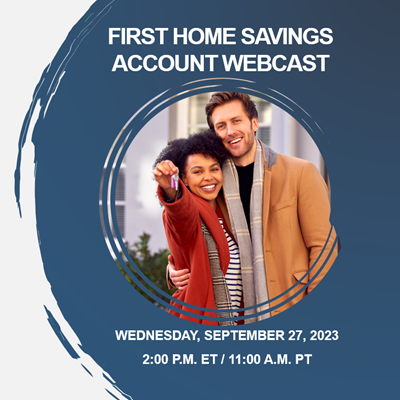First Home Savings Account (FHSA)
The Federal Government introduced a new savings vehicle for Canadians wanting to save for their first home. It’s called the First Home Savings Account.
Notable features
• Gives first-time homebuyers the ability to save up to $40,000 on a tax-free basis.• Like a Retirement Savings Plan (RSP), contributions are tax-deductible.
• Withdrawals to purchase a first home - including from investment income - are non-taxable, like a Tax-Free Savings Account (TFSA).
Who is eligible?
• Canadian residents, at least 18 years old.• First-time homebuyers who have not owned a home in which they lived at any time during the calendar year when the account is open or at any time in the preceding four calendar years.
What is the contribution limit?
• The lifetime limit on contributions to a FHSA is $40,000, with an annual contribution limit of $8,000. The annual contribution limit applies to contributions made within a particular calendar year. Deposits can only be made by the owner of the contract.• You can claim an income tax deduction for contributions made in a particular taxation year. Unlike RSPs, contributions made within the first 60 days of a given calendar year are not attributable to the previous tax year.
• You can carry forward unused portions of your annual contribution limit up to a maximum of $8,000. If you contribute less than $8,000 in a given year, you can contribute the unused amount (i.e., $8,000 less your contribution in that year) in a subsequent year on top of your annual contribution limit of $8,000. For example, if you contributed $5,000 to a FHSA in 2023, you would be allowed to contribute $11,000 in 2024 (i.e., $8,000 plus the remaining $3,000 from 2023). Carry-forward amounts only start accumulating after you open a FHSA for the first time.
What happens if I want to make a withdrawal?
• You must be a first-time homebuyer at the time of a withdrawal, and you can not have owned a home in which you lived in at any time during the calendar year when the withdrawal is made or at any time in the preceding four calendar years.• There is an exception that allows you to make qualifying withdrawals within 30 days of moving into your home. You must also have a written agreement to buy or build a qualifying home before October 1 of the year following the year of withdrawal and intend to occupy the qualifying home as your principal residence within one year after buying or building it. Provided you meet the qualifying withdrawal conditions, the entire amount of available FHSA funds may be withdrawn on a tax-free basis in a single withdrawal or a series of withdrawals.
• Form RC725, Request to Make a Qualifying Withdrawal from your FHSA, must be completed to request your FHSA withdrawal.
How does a FHSA compare with an RSP and TFSA?
Although there are similarities between a FHSA and RSP and TFSA, there are differences you may want to consider before deciding.
|
|
FHSA |
RSP |
TFSA |
|
Contributions deductible from income |
 |
 |
|
|
Withdrawal must be repaid |
|
 |
|
|
Withdrawal is tax free |
|
|
 |
|
Maximum withdrawal limit |
|
|
|
|
Withdrawal waiting period |
|
|
|
* If the withdrawal is not used for the purpose of purchasing a first home, it is a taxable withdrawal.
** Withdrawals are tax-deferred (not the same thing as tax free).
** Withdrawal cannot exceed $35,000.
**** RSP proceeds must be invested for at least 89 days before being withdrawn under the Home Buyers' Plan.
| Form Number | Cover | Marketing Material Name | Available Languages | Product |
|---|---|---|---|---|
| 2087 |
Daily/Guaranteed Interest Account Application - FHSA
File
Submit this request digitally via EZcomplete for faster processing. |
FR | ||
| 2086 |
Pivotal Select Application - FHSA
File
Submit this request digitally via EZcomplete for faster processing. |
FR |
| Form Number | Cover | Marketing Material Name | Available Languages | Product |
|---|---|---|---|---|
| 2125 |

|
Another reason to invest with Equitable
File
In case you need another reason, Equitable is a member of Assuris. Assuris is an independent, not for profit, industry-funded organization that protects contractholders, should their insurance company fail. |
FR | |
| 2089 |

|
First Home Savings Account
File
First Home Savings Account - One step closer to owning your first home |
FR | |
| 1965B |

|
Personalized Ads - Facts & Figures
File
Equitable is pleased to offer you professionally designed personalized ads to advertise. |
FR |
Who is eligible to open a First Home Savings Account (FHSA)?
This answer is based on the current information provided by the Canada Revenue Agency (CRA). These guidelines can change at any time without warning. For up-to-date information, please refer to Canada.ca/First Home Savings Account.The FHSA is available to Canadian residents who are first-time home buyers, at least 18 years of age and no older than 71 years of age on December 31st of the year the account is opened.1 For the purpose of the FHSA, first-time home buyer is defined as someone who has not at any time in the current year or in the preceding four years, lived in a home that the individual (in full or jointly), or the individual’s spouse or common-law partner has owned (in full or jointly).1
If a client is new to Canada and does not yet have a Social Insurance Number, can the client participate in the FHSA program?
A client can open a FHSA using a Temporary Tax Number.What product options are currently available at Equitable® for the FHSA?
Equitable is currently offering a FHSA in our Pivotal SelectTM segregated fund product. It is available in the Investment Class (75/75) and Estate Class (75/100) guarantee options.Which application is required to set up a FHSA?
Equitable has a stand-alone FHSA application for Pivotal Select segregated funds. This application is available on EZcomplete® and in paper format (Pivotal Select FHSA Application form # 2086).Can the client have more than one FHSA?
There are no limits to the number of FHSAs a client can have however, the total amount of the combined FHSA contributions cannot exceed the current annual maximum of $8,000 and lifetime limit of $40,000.1What happens if the client opens a FHSA but did not qualify as a first-time home buyer?
CRA will notify Equitable that the client did not qualify and that the FHSA is not valid.1 The fair market value will be deemed taxable to the client and taxes will be withheld on the proceeds.Who can be the successor annuitant on a FHSA?
Only a spouse or common-law partner can be designated as the successor annuitant on a FHSA.1
CONTRIBUTIONS AND CONTRIBUTION ROOM
What are the contribution guidelines for a FHSA?
The current maximum annual contribution for a FHSA is $8,000 and the lifetime maximum is$40,000.1
The client just opened a FHSA. Does the client have contribution room from previous years?
No. Contribution room only begins to accumulate once the FHSA is opened.Can the client do a first 60-day FHSA contribution that can be used toward the previous year’s income tax?
No. The first 60-days of a given calendar year cannot be applied to the previous tax year.Where can the client see the remaining FHSA contribution room?
Once the client opens a FHSA, CRA Notice of Assessment will indicate the available contribution room for the subsequent year.Can the client's spouse or parent make a deposit into their FHSA?
No. Only the owner of the FHSA can deposit money into their contract.Does a client need to have Registered Retirement Savings Plan (RRSP) contribution room available to make a FHSA contribution?
No. Contributions to a FHSA have no effect on RRSP contribution room.
Can the client carryover unused contribution amounts from previous years?
The maximum a client can carryover is $8,000 from the preceding calendar year.1 This means that the maximum deposit in any one year is $16,000 (if the client has not used the contribution room from the current year and the preceding year).What happens if the client overcontributes to the FHSA?
CRA will charge a tax of 1% per month on the highest excess FHSA amount in that month.1 This tax will continue to be charged until the excess amount is eliminated.1How can the client address excess funds in the FHSA?
Information on remedying excess contributions can be found on CRA’s website, Canada.ca/First Home Savings Account.Will Equitable notify advisors if the client overcontributes?
Equitable does not track overcontributions. The client will be notified by CRA in theevent of an overcontribution.
FHSA PARTICIPATION PERIOD
When does the client’s participation period in a FHSA program begin?
According to CRA, an individual’s participation period begins when the individual opens a FHSA. If the individual’s FHSA is opened with Equitable, the participation period begins on the date that all signatures are completed on the application. If the client is opening the FHSA, it is important to understand that submitting an application starts the participation period, even if the client chooses later not to proceed with the application.How long can the client’s FHSA remain open?
The participation period for a FHSA program ends on December 31th of the year in which the earliest of the following occur:- • the 15th anniversary of the opening of the client’s first FHSA1
- • the year following the first qualifying withdrawal from the FHSA1
- • the client turns 71 years of age1
How will Equitable know when the client is at the end of the participation period?
CRA will notify Equitable ahead of time to confirm the FHSA cessation date for all clients that hold a FHSA with us.1Will the client be notified about nearing the end of the participation period?
Equitable will send correspondence to a client prior to the end of the participation period to give the client an opportunity to provide instructions. If Equitable is not provided with alternate instructions prior to the end date, we will automatically transfer the value of the policy to a RRSP, based on the client’s age and in accordance with our administrative rules.
WITHDRAWALS
What conditions must be met for a client to make a qualifying withdrawal?
This answer is based on the current information provided by CRA. These guidelines can change at any time without warning. For up-to-date information, please refer to Canada.ca/First Home Savings Account.At the time of withdrawal, the client must meet the following conditions:
- • Be a Canadian resident who is a first-time home buyer.1 For the purpose of a FHSA, first-time home buyer is defined as someone who has not at any time in the current year or in the preceding four years, lived in a home that the individual (in full or jointly), or the individual’s spouse or common-law partner has owned (in full or jointly).1
- • Have a written agreement to buy or build a qualifying home before October 1st of the year following the year of withdrawal.1
- • Client must complete CRA form RC725, Request to Make a Qualifying Withdrawal from your FHSA.1
- • Must not have acquired the qualifying home more than 30 days before making the withdrawal.1
- • Must live in or intend to live in the qualifying home as the principal place of residence within one year after buying or building it.1
Is there withholding tax on a qualifying withdrawal?
No. If the client meets all the criteria for a qualifying withdrawal, Equitable is not required to withhold taxes.What happens if the client withdraws funds from the FHSA that is not for a qualified first-time home purchase?
Any non-qualifying withdrawals made from a FHSA must be claimed as income on the client’s tax return for the year the withdraw occurred. It is subject to income withholding tax. Please note as well that the client does not regain the contribution room in the FHSA.Can the client withdraw from the FHSA and the RRSP First Time Home Buyers Plan (HBP) on the same home purchase?
Yes. Both the FHSA and the HBP programs can be used on the same qualifying home purchase.Is there a maximum FHSA withdrawal amount like there is with the HBP?
No. There is no limit to how much the client can withdraw from the FHSA for a qualifying home purchase.The client processed a qualifying withdrawal from the FHSA for a home purchase. Can the client still make a subsequent contribution to the FHSA?
No. The client cannot make any more tax-deductible contributions to the FHSA after the client has processed a qualifying withdrawal.
TRANSFERS
Can a client transfer funds from an Equitable RRSP to a FHSA?
Yes. A client can transfer funds from a RRSP to a FHSA without immediate tax consequences if it does not exceed the unused FHSA participation room.1Will transferring funds from a client’s RRSP to a FHSA restore deduction room in the client’s RRSP?
No. Transferring funds from the client’s RRSP to a FHSA does not restore RRSP contribution room.1What form is used to transfer from a RRSP to a FHSA?
The form number is RC720, Transfer from your RRSP to your FHSA.Can the client transfer from a Registered Retirement Income Fund (RRIF) to a FHSA?
No. CRA does not allow transfers from a RRIF to a FHSA.Can a client transfer from a FHSA to a RRSP or RRIF?
Yes. CRA does permit transfers from the client’s FHSA to a RRSP or RRIF without immediate tax consequences.1What form is used to transfer from a FHSA to another FHSA, RRSP or RRIF?
The form number is RC721, Transfer from your FHSA to your FHSA, RRSP or RRIF.Can a client transfer from a FHSA to a Tax-Free Savings Account (TFSA) on a tax-deferred basis?
No. This would be considered a taxable withdrawal from a FHSA and a new contribution to the TFSA. Standard taxes would apply.1Will a client receive a contribution receipt if the client transfers money from a RRSP to a FHSA?
No. A contribution receipt is only provided for new money deposited into a FHSA. Transfers in are done on a tax-deferred basis and do not generate a contribution receipt.1What form is used to transfer FHSA proceeds in the event of a marriage breakdown?
The form number is RC723, Transfer from an FHSA to another FHSA, RRSP or RRIF on Breakdown of Marriage or Common-law Partnership.
TERMINATION
What options are available if a client no longer plans to use the FHSA to make a first-time home purchase?
If the client no longer plans to use the FHSA to purchase a home, the following alternative options are available:- • Make a taxable cash withdrawal.1
- • Transfer on a tax-deferred basis to the RRSP (or RRIF).1
If a client closes the FHSA, can the client open a new one?
The client can open a new FHSA if the client has not reached the end of the participation period and the client has not done a qualifying withdrawal.1 The participation period is based on the funding of the first FHSA.1What will Equitable do at the end of the FHSA participation period?
Our contractual procedure is to transfer the proceeds at that time to a RRSP (or RRIF if age 71) to prevent a taxable disposition to the client.
OTHER TAX-RELATED QUESTIONS
Will a client receive a tax receipt for the FHSA?
Yes. The client will receive a FHSA contribution receipt for transactions in the current year.Does a client have to claim a tax-deduction for the FHSA contribution in the year the contribution was made?
CRA allows the tax deduction to be carried over indefinitely to future tax years.If a client with a FHSA passes away and there is no spouse, how are the proceeds taxed?
The proceeds are fully taxable to the beneficiary. Also, tax is withheld prior to payment to the beneficiary.Downloadable Copy
SUPPORT
What support is available if I need assistance?
For more information or questions, contact your Regional Investment Sales Manager or Equitable Advisor Services Team.Advisor Services Team Contact Information Savings and Retirement
Phone: 1.866.884.7427
Email: SavingsRetirement@equitable.ca
1 This information is a summary of CRA guidelines. Please note that the CRA can change these guidelines at any time without notice.
™ or ® denote registered trademarks of The Equitable Life Insurance Company of Canada.


























.png)
.png)